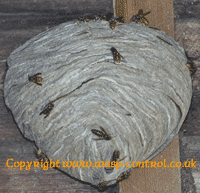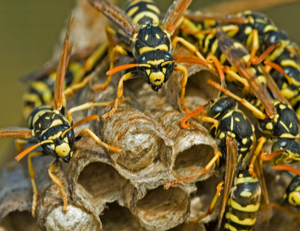wasp control can be a big problem for homeowners. They intrude on your property, pose a risk to the health of your family and pets, and, if left untreated, can cause significant structural damage to your house or yard.
But before you panic, remember this is a common problem with a straightforward solution. This guide will give you the basics of wasp nest removal, as well as tips and tricks you can use to keep them away in the future.
What Do I Need For Wasp Nest Removal?
Removal of a wasp nest can be dangerous, and it’s important to have the right tools for the job. Make sure you wear the appropriate protective gear like long pants and sleeves, gloves, and eye protection. You may also want to treat the affected area with insecticide before attempting to remove the nest. Depending on the size and location of the nest, you may need a ladder.

When Is the Best Time to Remove a Wasp Nest?
The best time to remove a nest is at night when the wasps are less active. If you wait until morning, the warm sun will rouse them, putting you at risk of being stung. In addition, darkness creates confusion in their behavior, making it more difficult for them to defend their nest.
Removing the Wasp Nest
Once you’ve taken all the necessary precautions, it’s time to deal with the nest. First, locate the entrance of the nest and spray insecticide into the entrance. This will kill most of the wasps inside, but some may still survive. Then, use a vacuum cleaner to collect the remaining wasps and discard the dead ones in a trash bag.
If the nest is located out of reach, you may need to call an exterminator. They have access to specialized tools that can help remove nests safely and efficiently. Make sure to choose an experienced exterminator who knows how to handle the job.
Preventing Future Wasp Problems
To prevent further wasp problems around your home, start by removing sources of food and water. This includes pet food, open garbage cans, and any standing water. Then, make sure all windows and doors are properly sealed to keep wasps from entering the house.
You should also inspect your house and yard regularly for new wasp activity. If you see any signs of wasps (such as droppings, nests, or swarms), take action immediately. Clean up possible food sources and seal any gaps or entry points to stop them from coming back.
Take Care of Your Wasp Problem Now!
Wasp nest removal is not something to take lightly. Take the steps necessary to protect your family and property, and get rid of the wasps for good. With the right tools, techniques, and knowledge, you can get rid of the problem quickly and safely.

